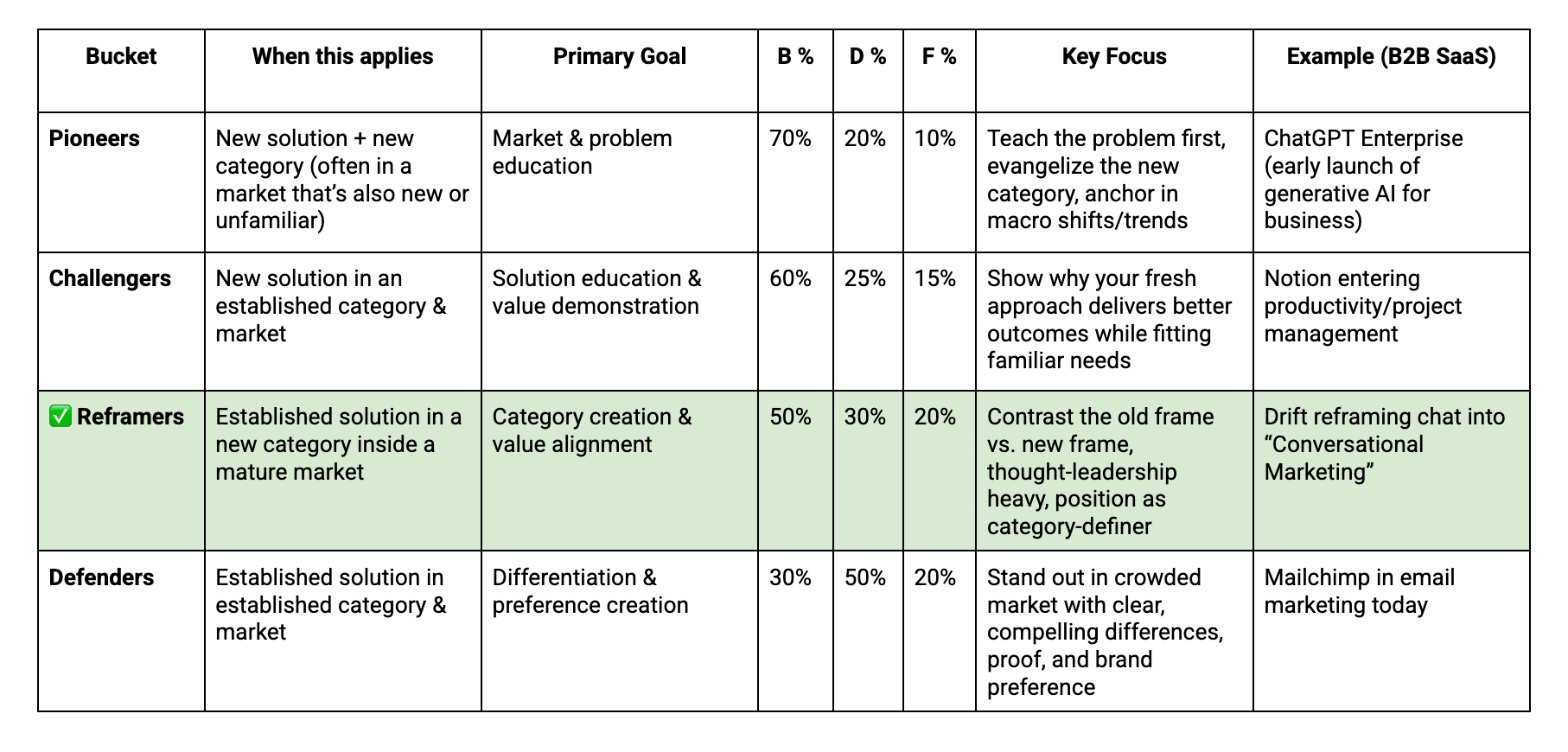How I diagnose and plan messaging with 3 questions
|
Welcome to Unpacking Meaning. If you received this from a friend and enjoy it, subscribe here. How I diagnose and plan messaging with 3 questionsAt the most fundamental level, what makes a piece of SaaS messaging effective? Is it clarity, emotion, differentiation—or some combination? On a recent podcast, someone asked me this question. My answer is, it depends. To determine whether clarity, emotion, or differentiation matters most in messaging, we first need to understand their linked aspects. The core components of any messaging are: benefits, features, and differentiators.
This frame effectively maps these 3 components to our initial question. Which is more important: clarity, emotion, or differentiation? If we see these through our frame, we get:
This leads us to the 3 “playing fields” that will dictate the importance and interaction of our elements. Solution, Category, and Market.
Spoiler alert, there’s no single element that makes messaging more effective. It’s the right balance of the 3 that makes messaging effective for your specific case in your playing field. For every client, we plan ahead for how we’ll deal with these in our messaging. That’s why our messaging framework document includes a section to help us through this. Here’s an example for Conversion Alchemy:
Solution maturity:
Category maturity:
Market maturity:
We fall squarely into the Reframer bucket. Our solution is proven, our market is mature, but our job is to reframe how SaaS teams think about messaging, not as words on a page, but as “infrastructure”. That means our split leans heavier on benefits (50%) and differentiators (30%), with just enough features (20%) to make it concrete. In practice, we spend less time convincing people what copy is and more time showing why our approach to it changes the game. To make this real, think about a few examples. ChatGPT Enterprise launched as a true Pioneer, everything was new, so the job was to evangelize the problem and category. Notion came in as a Challenger, entering the already-crowded project management space but proving it was faster and more flexible than incumbents. Drift played the Reframer role, taking an established tool (chat) and recasting it as “conversational marketing.” And today, Mailchimp is the classic Defender — in a saturated email market, it wins through preference, brand, and proof. Here’s how to find out where you fit, to make your messaging more impactful and effective for your ICPs. How to determine your fitAsk yourself three quick questions:
Now look at your answers:
So, to wrap up,what makes a piece of SaaS messaging effective, is striking the right balance between clarity, emotion, and differentiation. And you do it by evaluating where your solution, category, and market fit on the "Pioneer, Challenger, Reframer, Defender" spectrum. Go through these steps and let me know where you fit. I’d love to know and help you figure out how to address it in your messaging. DISCOVERYThe best SaaS homepage copy I've stumbled on recently and what you can learn from it:
RESONANCEYou must inevitably either hate or imitate the world. But the right thing is to shun both courses: you should neither become like the bad because they are many, nor be an enemy of the many because they are unlike you. Retire into yourself as much as you can. Associate with people who are likely to improve you." Seneca, Letters From a Stoic Have a great weekend! Cheers, Chris 🙌🏻 Let’s be friends (unless you’re a stalker) When you're ready, here's a few ways I can helpNot sure where to start? Take our free message-market fit scorecard. |
Hi, I'm Chris, The Conversion Alchemist
I'm the founder and chief conversion copywriter at Conversion Alchemy. We help 7 and 8 figure SaaS and Ecommerce businesses convert more website visitors into happy customers. Conversion Alchemy Journal is the collection of my thoughts, ideas, and ramblings on anything copy, UX, conversion rate optimization, psychology, decision-making, human behavior, and -often times - just bizarre, geeky stuff. Grab a cup of coffee and join me. Once a week, every Friday.
Read online Welcome to Unpacking Meaning. If you received this from a friend and enjoy it, subscribe here. Last week we talked about turning raw buying triggers into category entry points. But once you have them — how do you know which one will actually move buyers? That’s the question I keep getting on podcasts. “How do you test messaging fast, cheap, and without a full campaign?” It’s a fair ask. Because message validation is the biggest black box in B2B. Teams either A/B test blindly or...
Read online Welcome to Unpacking Meaning. If you received this from a friend and enjoy it, subscribe here. Forget channels. Focus on entry points. I’ve run 50+ messaging projects, and the same blind spot keeps showing up: what does it take for a prospect to even create space in their brain for you? Not to choose you over a competitor, or to justify you to a board. But to start thinking about a solution like yours in the first place. That’s the most underappreciated stage of the...
Read online Welcome to Unpacking Meaning. If you received this from a friend and enjoy it, subscribe here. My system for turning ICPs into actionable messaging One question I get asked a lot on podcasts is some variation of: “How do you create messaging and copy that work for different decision-makers?” The biggest misconception most marketing leaders have about B2B decision-makers is thinking they are their ICPs. If you’re selling a project management tool for agencies, you might say, “Our...

